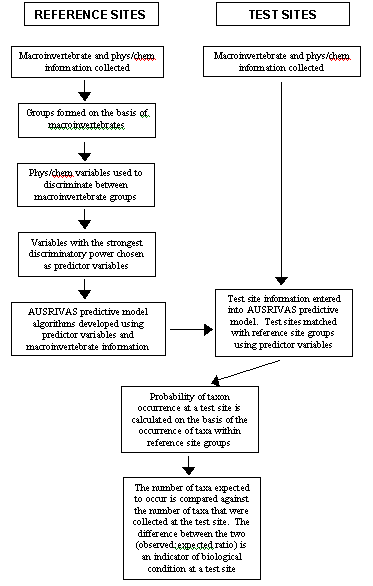
As of January 2004 au.riversinfo.org is archived under Precision Info
RIVERSINFO AUSTRALIA ARCHIVE
This archive provides non stylised versions of selected reference documents (formerly) resident on au.riversinfo.org.
A report to Environment Australia for the AUSRIVAS Physical and
Chemical Assessment Module
Melissa Parsons, Martin Thoms, Richard Norris
Cooperative Research Centre for Freshwater Ecology - April 2000

2. Review of river assessment methods
3. Summary and evaluation of river assessment methods
The aim of this document is to review existing stream assessment methods and as such, it draws heavily on published material. In describing the details of each method, it was sometimes difficult to diverge greatly from the existing text. Thus, we would like to acknowledge the creators of each stream assessment method, because this review is merely a summary of their expertise. These authors are:
However, it should be noted that the information supplied in this report is a synthesis and interpretation of published material and any misinterpretations, although unintentional, are the sole responsibility of the authors.
The Australian River Assessment System (AUSRIVAS) is a nationally standardised approach to biological assessment of stream condition using macroinvertebrates (Coysh et al., 2000). It was developed under the auspices of the National River Health Program (NRHP). Within the AUSRIVAS component of the NRHP, a suite of 'toolbox' projects have been commissioned with the aim of either refining the existing assessment techniques, or developing additional aspects of river health assessment that are complementary to those made by the AUSRIVAS macroinvertebrate predictive models (O'Connor, 1999). One of these projects is the development of a physical and chemical assessment module.
One of the main aims of the physical and chemical assessment module is to develop a standardised protocol for the physical and chemical assessment of stream condition, that will complement the biological assessments of stream condition made using AUSRIVAS. Disregarding the chemical component for now, development of such a protocol requires simultaneous consideration of stream condition from a biological and a physical perspective. While there would seem to be obvious interdependencies between the physical and biological components of streams, merging the two components is, in reality, a complex task because of the different paradigms that exist within the disciplines of stream ecology and fluvial geomorphology. The physical and chemical assessment module represents a first step in bringing together biological and physical or geomorphological approaches to the assessment of stream condition. However, in developing a standardised protocol for physical assessment of stream condition, that is directly relevant to biological assessment of stream condition, several questions become apparent:
The common link between assessment of stream condition from a biological and a geomorphological perspective is the expression of stream habitat, or physical structure, as a templet for biological communities. From a biological perspective, the physical habitat is considered as a templet upon which the ecological organisation and dynamics of ecosystems are observed (Townsend and Hildrew, 1994; Montgomery, 1999; Norris and Thoms, 1999). Thus, measurement of biological habitat tends to include the factors that directly influence biotic communities, at scales relevant to the organism of interest (Weins, 1989; Cooper et al., 1998; Sale, 1998) or the disturbance of interest (Rankin, 1995). From a geomorphological perspective, the expression of physical habitat is related to a set of predictable geomorphic processes (Harper and Everard, 1998; Muhar and Jungwirth, 1998; Brierley et al., 1999; Montgomery, 1999). The pattern of stream habitat that forms as a result of these processes provides the templet for biotic communities. Thus, measurement of geomorphological habitat tends to consider fluvial processes as they relate to channel structure, at scales that reflect the hierarchical organisation of stream systems (Schumm; 1977; Frissell et al., 1986; Maddock, 1999). Regardless of how each perspective views habitat, the common ground between geomorphology and biology is that both disciplines consider that a 'healthy' habitat is vital for a 'healthy' biotic community and indeed, for a 'healthy' stream ecosystem (Maddock, 1999; Norris and Thoms, 1999).
Biological monitoring programs are used worldwide to assess stream condition. The use of biota to assess stream condition has numerous advantages, the most prominent being that biotic communities are affected by a multitude of chemical and physical influences (Rosenberg and Resh, 1993). Thus, condition of the biota is a reflection of the overall condition of the stream ecosystem (Reice and Wohlenberg, 1993). However, there are numerous methods that have been developed to assess the physical or geomorphological condition of streams and which have the potential to enhance the interpretation of biological assessments of stream condition, or to provide information on stream condition that is not directly apparent within biological assessment. Any attempt to merge aspects of biological assessment with aspects of physical condition must identify the physical features that are of importance to the biota (Harper et al., 1995; Maddock, 1999), while retaining aspects that may be important to the physical formation of stream habitat.
The aim of this document is to review methods for the assessment of stream condition that are potential candidates for inclusion in a nationally standardised physical and chemical assessment protocol. It is not the aim of this document to make final recommendations for the format of the protocol. Rather, this review forms an initial information base and will be used in conjunction with a habitat assessment workshop to make final recommendations for a physical (and chemical) stream assessment protocol. The focus of this review is on assessment of the physical and geomorphological aspects of stream condition, with consideration of the potential for each method to link physical condition with ecological condition. It will answer four questions about each method:
The final section of the review will summarise the advantages and disadvantages of each physical assessment method and evaluate the potential for each method to encompass the physical aspects of river condition that are relevant to stream biota.
There are many stream assessment methods that have been developed worldwide. The methods chosen for inclusion in this review represent the suite of approaches currently in use in Australia. The State of the Rivers Survey, Index of Stream Condition and Geomorphic River Styles methods were developed for, and tested in, Australian rivers and streams. Thus, they tend to have an ability to incorporate stream features inherent to Australian conditions such as high flow variability, high turbidity and complex channel morphology. Although based on a method developed in the United Kingdom, the AUSRIVAS and Habitat Predictive Modelling methods have been successfully adapted to Australian conditions. In particular, AUSRIVAS is a nationally standardised and predictive approach to biological assessment that has recently been used to determine the condition of around 6000 river sites across Australia. The United States Environmental Protection Agency's HABSCORE method of stream assessment was used within the AUSRIVAS predictive model and thus, is included in this review. The River Habitat Survey is not currently being applied in Australia. However, it is included in this review because it represents an approach that was applied on a national scale in the United Kingdom, to assess the physical condition of streams and rivers.
There are some additional methods of stream assessment that were not included in the review. The Integrated Habitat Assessment System (IHAS) has been developed in South Africa and is used in conjunction with the country's rapid biological assessment program (McMillan, 1998). The IHAS measures components of the stream habitat relevant to macroinvertebrates, such as substratum, vegetation and physical stream condition. These components are rated and a score representing a continuum of habitat quality is derived. Another method, Pressure-Habitat-Biota (PBH), has been developed for use in small to medium sized rivers and streams in New South Wales (Chessman and Nancarrow, 1999). PBH measures variables representing the pressures on streams (e.g. physical restructuring, water pollution and introduced species), the habitat of streams (e.g. habitat area, habitat diversity and habitat stability) and the biota within streams (e.g. diatoms, riparian vegetation, water plants, macroinvertebrates and fish). These variables are then compared with each other to:
In addition to the IHAS and PBH methods, the United Kingdom's System for Evaluating Rivers for Conservation (SERCON) was also omitted from this review. SERCON is designed to assess the conservation value of rivers according to criteria of physical diversity, naturalness, representativeness, rarity, species richness and special features (Boon et al., 1998). Field data are collected using an extended version of the River Habitat Survey, and other data are gathered from a range of sources. Rating scores are derived for each variable and these scores are subsequently combined to produce indices for each of the conservation criteria described above (Boon et al., 1998).
Overall, the rationale for omission of IHAS, PBH and SERCON from this review is somewhat subjective and has no relationship to the mechanisms that each method uses to assess stream condition. Rather, the IHAS and PBH methods were omitted because they are still in the development stage and thus, there was a limited amount of literature available. SERCON is a complex system for evaluating conservation potential and thus, it was decided that the inclusion of SERCON's smaller sibling, the River Habitat Survey, would provide an adequate description of the potential for this method to assess physical stream condition.
The Australian River Assessment System (AUSRIVAS) was developed in response to the need for a nationally standardised method to assess the ecological condition of Australia's river systems (Simpson and Norris, 2000). The AUSRIVAS approach is based on the British River InVertebrate Predication and Classification System (RIVPACS, Wright et al., 1984; Moss et al., 1987), which has been successfully used to assess the quality of rivers in the U.K. (Wright et al., 1998). Initially, the adoption of RIVPACS to Australian conditions required modifications to the sampling design and statistical analysis components (Simpson and Norris, 2000). The major advantage of the AUSRIVAS and RIVPACS approaches to river assessment is that the fauna expected to occur at a site can be predicted, forming a 'target' community against which to measure potential ecological impairment.
AUSRIVAS uses macroinvertebrate information as the basis upon which to assess the ecological condition of river sites (Figure 2.2.1). Macroinvertebrates are collected from reference sites, which are defined as sites representing least impaired conditions. Classification analysis is then used to form reference sites into groups containing similar biota. Physical and chemical data collected at reference sites are then used to discriminate among the biotic groups and the variables with the strongest discriminatory power are chosen as predictor variables for use in the AUSRIVAS predictive model algorithm.
The reference site information forms the templet against which test sites are compared to assess their ecological condition (Figure 2.2.1). A test site is defined as any new site for which an assessment is required. Macroinvertebrates are collected at the test sites, along with a suite of physical and chemical information that includes the predictor variables chosen for use in the AUSRIVAS model. These predictor variables are used to place test sites into the reference site groups formed on the basis of the biota. The model then calculates the probability of occurrence of each taxon at a test site, based on the occurrence of each taxon within the corresponding reference site groups. The number of taxa predicted to occur at a test site is compared against the number of taxa that were actually collected at the test site, with the difference between the two being an indication of the ecological condition of the site.
 |
| Figure 2.2.1 Schematic representation of AUSRIVAS assessment of site condition. |
Macroinvertebrates are a commonly used group of organisms in the biological monitoring of water quality (Rosenberg and Resh, 1993). From an ecological perspective, the advantages of using macroinvertebrates to assess river condition are that they are common in many different river habitats, they show responses to a wide range of environmental stresses and they act as continuous monitors of the water that they inhabit (Rosenberg and Resh, 1993). Thus, the ecological foundation upon which biological monitoring is based is that the structure of the benthic macroinvertebrate community indicates the state of the entire ecosystem (Reice and Wohlenberg, 1993).
AUSRIVAS assesses site condition by comparing the macroinvertebrates that are predicted to occur at a test site, with the macroinvertebrates that were collected at a test site. The deviation between the number of taxa expected to occur and the number of taxa that were actually observed (observed:expected ratio) is a measure of the ecological condition of a site. If the number, or type, of taxa collected at a test site does not fulfil expectations, then it is likely that water quality or habitat conditions are limiting the biological potential of the site. The observed:expected ratio ranges from 0 to > 1 and represents a continuum of ecological condition. For ease of interpretation, the continuum can be broken into bands that delineate an ecological condition that is impoverished, well below reference, below reference, reference, and richer than reference (Simpson and Norris, 2000).
The robustness of AUSRIVAS assessments of site condition are enhanced through the use of a regional reference condition approach (Reynoldson et al., 1997). Comparison of test sites to groups of reference sites that represent an array of potential regional conditions enables prediction of the taxa likely to occur at sites with given environmental characteristics (Moss et al., 1987; Reynoldson et al., 1997). In predicting the taxa that should occur at a test site, the AUSRIVAS model calculates the weighted probabilities of a test site belonging to each of the reference site groups, which in turn enables natural variation in macroinvertebrate habitat associations to be accounted for before determining site condition. However, there are several limitations of the AUSRIVAS predictive models that currently have the potential to affect assessments of site condition. First, to allow accurate matching of test sites with reference site groups, reference sites must cover a wide range of river types. Secondly, evaluation of whether macroinvertebrate community impairment detected by AUSRIVAS is likely to be caused by water quality degradation, habitat degradation, or a combination of both is highly dependent upon the collection of the appropriate supporting data from each test site.
The fundamental assumption behind AUSRIVAS is that the physical and chemical factors measured at any site are directly related to the macroinvertebrates. This assumption is derived from a multitude of studies that have demonstrated specific physical and chemical influences on macroinvertebrate community structure in streams (Resh and Rosenberg, 1984; Vinson and Hawkins, 1998; Ward, 1992). The empirical evidence linking macroinvertebrates with their environmental requirements provides a strong foundation for the process that AUSRIVAS uses to link physical and chemical variables to taxon occurrence, and the subsequent assessments of ecological condition that are derived from this information.
The physical and chemical variables collected in AUSRIVAS broadly encompass the factors that influence the distribution of macroinvertebrates on a catchment, reach and individual habitat scale. These factors are geographical position, riparian vegetation, channel morphology, water chemistry, habitat composition, habitat characteristics, organic substratum, inorganic substratum and hydrology (Table 2.2.1). Within each factor, a number of different variables are measured to represent specific influences on macroinvertebrate communities (Table 2.2.1). In addition, the US EPA habitat assessment (see Section 2.3) is also performed at each site and a suite of observations that indicate potential human influences are recorded and used to aid interpretation of AUSRIVAS biological outputs (Table 2.2.1). However, there are several shortcomings of the physical and chemical data that may affect the AUSRIVAS assessments of ecological condition. Firstly, AUSRIVAS sampling is conducted by State agencies. As such, the specific variables measured in each State vary slightly according to both geographical and administrative need, although the major factors influencing macroinvertebrate distribution are generally encompassed by each State. Secondly, AUSRIVAS assumes a deterministic link between physical and chemical factors and macroinvertebrates, and thus, the predictive capability of the model depends on the ability to capture the variables that most strongly influence macroinvertebrate distribution. While the choice of variables included in the models has a strong empirical basis, it is not clear whether these variables encompass all the potential influences on macroinvertebrate communities. In particular, variables that represent habitat forming geomorphological processes, such as stream power and channel dimension, are omitted from AUSRIVAS. However, the relationship between the habitats that these geomorphological processes form, and the habitat requirements of macroinvertebrates is a contentious issue that has only recently come to the fore of research agendas.
| Table 2.2.1 Physical and chemical variables commonly measured in AUSRIVAS. Broad categories of factors influencing macroinvertebrate distribution are in bold, with the specific variables measured within each factor listed underneath. Compiled from State Agency data sheets. | |
|---|---|
|
Geographical position
Riparian vegetation
Channel morphology
Water chemistry
Hydrology
Habitat composition
Reach organic and inorganic substratum
|
Riffle/channel/sand bed habitat characteristics
Edge/backwater/macrophyte habitat characteristics
Habitat quality assessment (US EPA)
Site observations
|
The United States Environmental Protection Agency (USEPA) has developed Rapid Bioassessment Protocols (RBP) that use fish, macroinvertebrates or periphyton to assess stream condition. Metrics representing structural, functional and process elements of the biotic community are calculated for each site, and aggregated into an index. This multimetric index represents the biological condition of a site (Barbour et al., 1999). Physical and chemical data are also measured at each site, and are used to aid the interpretation and calibration of the index, and also to define the reference condition. It is beyond the scope of this document to consider the process of biological metric calculation and calibration. Rather, the focus will be on the suite of physical and chemical measurements that are collected alongside the biota. In particular, the RBP includes a rapid habitat assessment method that uses a scoring system to rate habitat condition, and which will henceforth be referred to as HABSCORE. HABSCORE has utility outside the Rapid Bioassessment Protocols and has been used as a measure of habitat condition in the AUSRIVAS predictive models (see Section 2.2) and in the Habitat Predictive Modelling approach (see Section 2.7). HABSCORE was originally adopted by Plafkin et al. (1989) from work conducted on fish habitat, but has subsequently been updated and modified slightly by Barbour et al. (1999). The following discussion refers to the updated version of HABSCORE.
The USEPA Rapid Bioassessment Protocols were developed in response to a need for cost effective survey techniques to assess stream condition (Barbour et al., 1999). The principal requirements underpinning the protocols were:
The HABSCORE component of the Rapid Bioassessment Protocols is commensurate with these requirements.
HABSCORE is a visually based habitat assessment that evaluates 'the structure of the surrounding physical habitat that influences the quality of the water resource and the condition of the resident aquatic community' (Barbour et al., 1999, p5-5). It includes factors that characterise stream habitat on a micro-scale (e.g. embeddedness) and a macro-scale (e.g. channel morphology), as well as factors such as riparian and bank structure which influence the micro and macro-scale features (Barbour, 1991; Barbour et al., 1999). HABSCORE is composed of ten habitat parameters (Figure 2.3.1). To reflect the difference in habitat types between upland and lowland streams, separate assessments have been developed for high and low gradient conditions (Barbour et al., 1999). At each site, individual parameters are assessed and rated according to a continuum of scores that represent optimal, sub-optimal, marginal or poor condition (Figure 2.3.1). A total score is obtained for each site, and is subsequently used to determine the percent comparability to reference conditions (Plafkin et al., 1989). However, the individual parameter scores and the total assessment score also provide an overall assessment of habitat condition at the sampling site.
| HABITAT ASSESSMENT FIELD DATA SHEET Page 1 of 2 | |
| HIGH GRADIENT STREAMS | |
| Date: _______________ | Recorders Name: ______________________________ |
| Site No.: _______________ | River and Location: ______________________________ |
| Habitat parameter | Condition category |
||||||||||||||||||||
| Excellent | Good | Fair | Poor | ||||||||||||||||||
| 1. Epifaunal (bottom) substrate / available cover | Greater than 70% of substrate favourable for epifaunal colonisation and fish cover; mix of snags, submerged logs, undercut banks, cobble or other stable habitat and at stage to allow full colonisation potential (i.e. logs/snags that are not new fall and not transient). | 40-70% mix of stable habitat; well-suited for full colonisation potential; adequate habitat for maintenance of populations; presence of additional substrate in the form of newfall, but not yet prepared for colonisation (may rate at high end of scale). | 20-40% mix of stable habitat; habitat availability less than desirable; substrate frequently disturbed or removed. | Less than 20% stable habitat; lack of habitat is obvious; substrate unstable or lacking. | |||||||||||||||||
| SCORE | 20 | 19 | 18 | 17 | 16 | 15 | 14 | 13 | 12 | 11 | 10 | 9 | 8 | 7 | 6 | 5 | 4 | 3 | 2 | 1 | 0 |
| 2. Embeddedness | Gravel, cobble and boulder particles are 0-25% surrounded by fine sediment. Layering of cobble provides diversity of niche space. | Gravel, cobble and boulder particles are 25-50% surrounded by fine sediment. | Gravel, cobble and boulder particles are 50-75% surrounded by fine sediment. | Gravel, cobble and boulder particles are more than 75% surrounded by fine sediment. | |||||||||||||||||
| SCORE | 20 | 19 | 18 | 17 | 16 | 15 | 14 | 13 | 12 | 11 | 10 | 9 | 8 | 7 | 6 | 5 | 4 | 3 | 2 | 1 | 0 |
| 3. Velocity / depth regime | All four velocity/depth regimes present (slow-deep, slow-shallow, fast-deep, fast-shallow). Slow is <0.3m/s, deep is >0.5m). | Only 3 of the 4 regimes present (if fast-shallow is missing, score lower than if missing other regimes). | Only 2 of the 4 habitat regimes present (if fast-shallow or slow-shallow are missing, score low). | Dominated by 1 velocity/depth regime (usually slow-deep). | |||||||||||||||||
| SCORE | 20 | 19 | 18 | 17 | 16 | 15 | 14 | 13 | 12 | 11 | 10 | 9 | 8 | 7 | 6 | 5 | 4 | 3 | 2 | 1 | 0 |
| 4. Sediment deposition | Little or no enlargement of islands or point bars and less than 5% of the bottom affected by sediment deposition. | Some new increase in bar formation, mostly from gravel, sand or fine sediment; 5-30% of the bottom affected; slight deposition in pools. | Moderate deposition of new gravel, sand or fine sediment on old and new bars; 30-50% of the bottom affected; sediment deposits at obstructions, constrictions and bends; moderate deposition in pools prevalent. | Heavy deposits of fine material, increased bar development; more than 50% of the bottom changing frequently; pools almost absent due to substantial sediment deposition. | |||||||||||||||||
| SCORE | 20 | 19 | 18 | 17 | 16 | 15 | 14 | 13 | 12 | 11 | 10 | 9 | 8 | 7 | 6 | 5 | 4 | 3 | 2 | 1 | 0 |
| 5. Channel flow status | Water reaches base of both lower banks, and minimal amount of channel substrate is exposed. | Water fills >75% of the available channel; or <25% of channel substrate is exposed. | Water fills 25-75% of the available channel, and/or riffle substrates are mostly exposed. | Very little water in channel and mostly present as standing pools. | |||||||||||||||||
| SCORE | 20 | 19 | 18 | 17 | 16 | 15 | 14 | 13 | 12 | 11 | 10 | 9 | 8 | 7 | 6 | 5 | 4 | 3 | 2 | 1 | 0 |
| 6. Channel alteration | Channelization or dredging absent or minimal; stream with normal pattern. | Some channelization present, usually in areas of bridge abutments; evidence of past channelization, i.e. dredging (greater than 20 yr) may be present, but recent channelization is not present. | Channelization may be extensive; embankments or shoring structures present on both banks; and 40 to 80% of stream reach channelized and disrupted. | Banks shored with gabion or cement; over 80% of the stream reach channelized and disrupted. Instream habitat greatly altered or removed entirely. | |||||||||||||||||
| SCORE | 20 | 19 | 18 | 17 | 16 | 15 | 14 | 13 | 12 | 11 | 10 | 9 | 8 | 7 | 6 | 5 | 4 | 3 | 2 | 1 | 0 |
Figure 2.3.1 Habitat assessment data sheet for high gradient streams, showing habitat parameters assessed for HABSCORE. Each parameter is scored on a continuum of conditions representing optimal, sub-optimal, marginal and poor conditions. The score is totalled and to form the overall assessment of habitat quality. After Barbour et al. (1999).
| HABITAT ASSESSMENT FIELD DATA SHEET Page 2 of 2 | |
| HIGH GRADIENT STREAMS | |
| Date: _______________ | Recorders Name: ______________________________ |
| Site No.: _______________ | River and Location: ______________________________ |
| Habitat parameter | Condition category | ||||||||||||||||||||||||||
| Excellent | Good | Fair | Poor | ||||||||||||||||||||||||
| 7. Frequency of riffles (or bends) | Occurrence of riffles relatively frequent; ratio of distance between riffles divided by width of the stream <7:1 (generally 5 to 7); variety of habitat is key. In streams where riffles are continuous, placement of boulders or other large, natural obstruction is important. | Occurrence of riffles infrequent; distance between riffles divided by the width of the stream is between 7 to 15. | Occasional riffle or bend; bottom contours provide some habitat; distance between riffles divided by the width of the stream is between 15 to 25. | Generally all flat water or shallow riffles; poor habitat; distance between riffles divided by the width of the stream is a ratio of >25. | |||||||||||||||||||||||
| SCORE | 20 | 19 | 18 | 17 | 16 | 15 | 14 | 13 | 12 | 11 | 10 | 9 | 8 | 7 | 6 | 5 | 4 | 3 | 2 | 1 | 0 | ||||||
| 8. Bank stability (score each bank) | Banks stable; evidence of erosion or bank failure absent or minimal; little potential for future problems. <5% of bank affected. | Moderately stable; infrequent, small areas of erosion mostly healed over. 5-30% of bank in reach has areas of erosion. | Moderately unstable; 30-60% of bank in reach has areas of erosion; high erosion potential during floods. | Unstable; many eroded areas; 'raw' areas frequent along straight sections and bends; obvious bank sloughing; 60-100% of bank has erosional scars. | |||||||||||||||||||||||
| SCORE | Left bank | 10 | 9 | 8 | 7 | 6 | 5 | 4 | 3 | 2 | 1 | 0 | |||||||||||||||
| SCORE | Right bank | 10 | 9 | 8 | 7 | 6 | 5 | 4 | 3 | 2 | 1 | 0 | |||||||||||||||
| 9. Vegetative protection (score each bank) | More than 90% of the streambank surfaces and immediate riparian zone covered by native vegetation, including trees, understorey shrubs, or non woody macrophytes; vegetative disruption through grazing or mowing minimal or not evident; almost all plants allowed to grow naturally. | 70-90% of the streambank surfaces covered by native vegetation, but one class of plants is not well-represented; disruption evident but not affecting full plant growth potential to any great extent; more than one half of the potential plant stubble height remaining. | 50-70% of the streambank surfaces covered by vegetation; disruption obvious; patches of bare soil or closely cropped vegetation common; less than one-half of the potential plant stubble height remaining. | Less than 50% of the streambank surfaces covered by vegetation; disruption of streambank vegetation is very high; vegetation has been removed to 5 centimetres or less in average stubble height. | |||||||||||||||||||||||
| SCORE | Left bank | 10 | 9 | 8 | 7 | 6 | 5 | 4 | 3 | 2 | 1 | 0 | |||||||||||||||
| SCORE | Right bank | 10 | 9 | 8 | 7 | 6 | 5 | 4 | 3 | 2 | 1 | 0 | |||||||||||||||
| 10. Riparian zone score (score each bank) | Width of riparian zone >18 metres; human activities (i.e. roads, lawns, crops etc.) have not impacted the riparian zone. | Width of riparian zone 12-18 metres; human activities have impacted riparian zone only minimally. | Width of riparian zone 6-12 metres; human activities have impacted zone a great deal. | Width of riparian zone <6 metres; little or no riparian vegetation is present because of human activities. | |||||||||||||||||||||||
| SCORE | Left bank | 10 | 9 | 8 | 7 | 6 | 5 | 4 | 3 | 2 | 1 | 0 | |||||||||||||||
| SCORE | Right bank | 10 | 9 | 8 | 7 | 6 | 5 | 4 | 3 | 2 | 1 | 0 | |||||||||||||||
TOTAL HABITAT SCORE _________________
Figure 2.3.1 (cont. - above)
In addition to the HABSCORE assessment of site condition, a suite of variables that represent factors integrated within HABSCORE are also collected at each site. These factors characterise stream type, watershed features, riparian vegetation, instream features, large woody debris, aquatic vegetation, water quality, inorganic substrate and organic substrate (Table 2.3.1). These factors can be included in determinations of reference condition, but are mostly used as an interpretative aid to the assessments of stream condition, made using the multimetric indices. These variables are also collected in AUSRIVAS (see Section 2.2) but are used mainly to aid interpretation of site condition, rather than as predictor variables.
| Table 2.3.1 Physical and chemical observations measured alongside the HABSCORE assessment. After Barbour et al. (1999). | |
|---|---|
|
Watershed features
Riparian Vegetation
Instream features
Large woody debris
|
Aquatic vegetation
Water quality
Inorganic sediment/substrate
Organic substrate
|
As a stand-alone method, HABSCORE provides an ability to assess the quality of instream and riparian habitat at a sampling site. However, a more important function of HABSCORE is that it is used to determine the ability of the habitat to support the optimal biological condition of the region (Barbour et al., 1999). Assuming that reference sites represent optimal condition, the comparability of the habitat and the biota to this reference state can be plotted to determine the ability of the habitat to support the biological community (Figure 2.3.2). There are three important aspects of Figure 2.3.2:
Apart from the three situations outlined above, comparison of the condition of the biota with the condition of the habitat can also highlight situations of potential water quality degradation, where habitat quality is high but biological condition is poor (Barbour et al., 1999).
Habitat quality is the initial focus of the Rapid Bioassessment Protocols. Habitat quality at the reference sites is compared against habitat quality at the test site and if equivalent, then a direct comparison of the biological condition can be made using the biological metrics (Plafkin et al., 1989). This ensures that assessments of biological condition indicate impairment, rather than inherent natural differences in stream habitat. If habitat quality is lower at a test site than at the reference sites, then the ability of the habitat to support biota is investigated as a first step, before a determination of biological condition is made (Plafkin et al., 1989).
HABSCORE was designed to complement assessments of biological condition made using the rapid biological assessment protocols. This compatibility is based on the assumption that the quality and quantity of available physical habitat has a direct influence on biotic communities (Maddock 1999; Rankin, 1995). The parameters measured in HABSCORE (Figure 2.3.1) represent aspects of the habitat that are related to aquatic life use and which are a potential source of limitation to the aquatic biota (Barbour, 1991; Barbour et al., 1999). Thus, the empirical links between habitat and the biota are reflected in this relationship. The process used to determine the ability of the habitat to support an optimal biological community (see Section 2.3.3) also captures these empirical links by considering habitat quality to be a templet that influences the types of biotic communities that can potentially be attained under certain conditions.
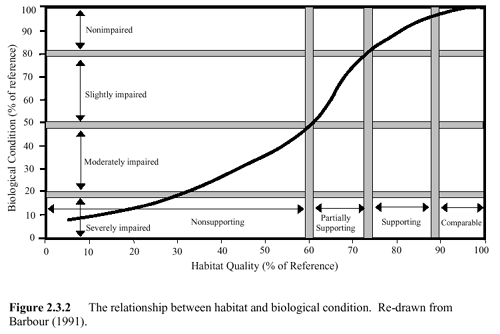 |
| Figure 2.3.2 The relationship between habitat and biological condition. Re-drawn from Barbour (1991). |
Australian Governments are increasing their focus on rivers via legislative, research and rehabilitation actions (Ladson et al., 1999). Within this environment, the Victorian Index of Stream Condition (ISC) was developed in response to a managerial need to 'use indicators to track aspects of environmental condition and provide managerially or scientifically useful information' (Ladson et al., 1999, p454).
The ISC evolved in four stages. Stage 1 involved the development of the concept and included a review of stream assessment methods, input from stream scientists and managers, and development of an ISC prototype (Ladson and White, 1999). The desired attributes considered in development of the ISC concept were:
Stage 1 is analogous to the aims of the current Physical and Chemical Assessment Module. Stages 2 and 3 of the ISC involved trialing and refining the concept and Stage 4 involved application of the ISC across Victoria (Ladson and White, 1999). Future stages will involve assessment and further refinement of the method (Ladson and White, 1999).
The ISC measures stream condition within reaches that are between 10 and 30km in length (Ladson and White, 1999). Reaches are defined as 'contiguous sections of stream chosen so that they are approximately homogeneous in terms of the five components of stream condition' (Ladson et al., 1999 p456). Reaches are delineated mainly from
1:250 000 topographic maps or aerial photographs. Within each reach, measurement sites are selected on the basis of:
The ISC consists of five sub-indices, which represent key components of stream condition (Table 2.4.1). Each sub-index consists of indicators, which are calculated using data collected in the field or by desk based methods. Each indicator is then assigned a rating score (see Section 2.4.3). Sub-index scores are calculated by summing the component indicator scores, and the overall ISC score is calculated by summing the sub-index scores (Ladson et al., 1999).
| Table 2.4.1 List of indicators used in the Index of Stream Condition. After Ladson and White (1999) and Ladson et al. (1999). | ||
|---|---|---|
| Sub-index | Basis for sub-index value | Indicators within sub-index |
| Hydrology | Comparison of the current flow regime with the flow regime existing under natural conditions | Amended annual proportional flow deviation Daily flow variation due to change of catchment permeability Daily flow variation due to peaking hydroelectricity stations |
| Physical Form | Assessment of channel stability and amount of physical habitat | Bank stability Bed stability Impact of artificial barriers on fish migration Instream physical habitat |
| Streamside Zone | Assessment of quality and quantity of streamside vegetation | Width of streamside zone Longitudinal continuity Structural intactness Cover of exotic vegetation Regeneration of indigenous woody vegetation Billabong condition |
| Water Quality | Assessment of key water quality parameters | Total phosphorus Turbidity Electrical conductivity Alkalinity / acidity |
| Aquatic Life | Presence of macroinvertebrate families | SIGNAL AUSRIVAS |
The ISC uses a rating system to assess stream condition. The use of a rating system is designed to provide as much resolution as possible, within the constraint that there is 'limited knowledge of the relationship between a change in the indicator and environmental effects' (Ladson and White, 1999, p10). Values for each indicator are assigned a rating on the basis of comparison with a reference state (Figure 2.4.1). These ratings are summed to produce an overall score that reflects a continuum of stream conditions from excellent to very poor (Figure 2.4.1). In calculating the overall ISC scores, the scores for each sub-index and for each indicator can be weighted, depending on the perceived importance of each, or the availability of data (Ladson and White, 1999).
The ISC is based on the premise that the hydrology, physical form, streamside zone, water quality and aquatic life components indicate the processes and functions that act to influence stream condition. For example, the hydrology sub-index reflects deviation of the current flow regime from natural conditions, the physical form sub-index reflects channel morphology and the provision of biotic habitat, and the streamside zone sub-index reflects the importance of riparian zone and floodplain processes (Ladson and White, 1999; Ladson et al., 1999). A holistic assessment of stream condition is achieved by integrating these components into a single ISC score. However, it is recommended that the scores for the component sub-indices are reported alongside the overall ISC score, because the overall score may be composed of sub-indices that vary in condition (Ladson and White, 1999).
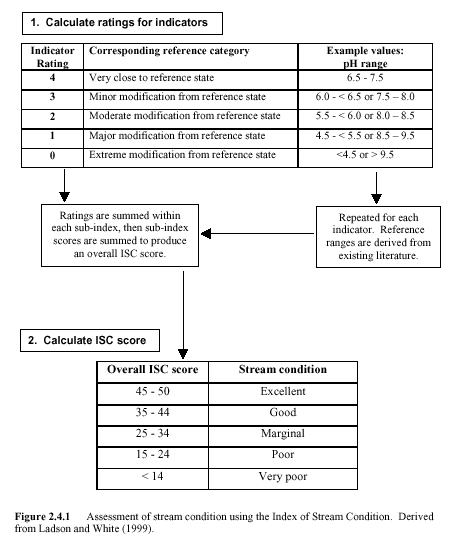 |
| Figure 2.4.1 Assessment of stream condition using the Index of Stream Condition. Derived from Ladson and White (1999). |
The ISC was designed to provide an assessment of long term changes in the environmental condition of rural stream reaches 10-30km in length, with surveys conducted at five year intervals (Ladson and White, 1999). As such, the 'level of detail is only sufficient to signal potential problems, suggest their cause and highlight aspects that may need specific investigations' (Ladson et al., 1999, p455). However, the ISC is a tool for determining the success of environmental intervention policies (Ladson and White, 2000) and can be used in a management context to:
The ISC is designed to be a broad scale and long term assessment. As such, the ISC consists of five sub-indices that reflect different components of stream condition. The aquatic life sub-index is the component that reflects overall biotic condition within the sampling reach (Ladson and White, 1999). Macroinvertebrate indicators are used in the ISC, because this group of organisms provides a continuous assessment of the environment which they inhabit (Rosenberg and Resh, 1993; Ladson and White, 1999). As such, the aquatic life sub-index is inherently related to the hydrology, physical form, streamside zone and water quality sub-indices (Ladson and White, 1999). Inclusion of the aquatic life sub-index provides a somewhat independent measure of stream condition, and can be particularly useful in situations where the biota are degraded but the physical, chemical and hydrological indices are not (Ladson and White, 1999). While there is empirical evidence that broadly links degradation in physical, chemical and hydrological factors with degradation in macroinvertebrate communities, care must be taken when comparing scores for the aquatic life sub-index with scores for the other sub-indices. This is because a scoring system may not be a sensitive reflection of mechanistic relationships between environmental factors and macroinvertebrate community composition.
River health has traditionally been viewed from a biological perspective, because 'effects on biota are usually the final point of environmental degradation and pollution of rivers' (Norris and Thoms, 1999, p197). However, there is an inherent link between the potential health of biota, and the availability of physical habitat (Brierley et al., 1999). As such, assessment of river health from a biological perspective cannot proceed effectively when analysed in isolation from the factors that determine river structure and function. Geomorphic River Styles aims to address the physical structure and function components of river health. It is framed around 'direct linkage of vegetative and geomorphic process, providing an assessment of habitat availability along river courses, and hence indirect linkage to river ecology' (Brierley et al., 1996, p2).
Assessment of stream condition from a distinctly geomorphological perspective has many benefits to river managers, including:
Geomorphic River Styles is a procedure that provides 'a baseline survey of river character and behaviour, evaluating the physical controls on river structure at differing positions in catchments' (Brierley et al., 1996, p2). The procedure is set within a nested hierarchical framework (Frissell et al., 1986) and as such, it incorporates assessment of river structure at the catchment, reach and geomorphic unit scales (Brierley et al., 1996).
There are five stages in the assessment of river character and behaviour:
Stage one comprises both pre-field data collection and field data collection (Brierley et al., 1996). During the pre-field data collection component, catchment scale characteristics are measured off maps, or by using GIS capabilities (Table 2.5.1). Consideration is also given to historical and archival information about the catchment. In addition, the pre-field component involves identification of reach boundaries off 1:12000 air photographs and a range of reach scale characteristics is subsequently measured at each reach (Table 2.5.1). The reaches delineated off maps are used as sampling units in the field data collection component (Brierley et al., 1996), although the reaches are ratified in the field prior to data collection. Geomorphic units are identified within each reach and at representative locations, the characteristics of each geomorphic unit are recorded (Table 2.5.1). A detailed sediment analysis is also conducted in each geomorphic unit (Table 2.5.1).
In Stage two, data collected in the pre-field and field components are used to interpret river behaviour. This process involves several steps and follows the hierarchical framework. Firstly, the assemblage of geomorphic units is assessed, to provide insight into the formative processes within a reach (Brierley et al., 1996).
| Table 2.5.1 Catchment, reach and geomorphic unit characteristics measured in the Geomorphic River Styles method. After Brierley et al. (1996). | |
|---|---|
|
CATCHMENT CHARACTERISTICS Relief measures
Areal properties
Linear measurements
Other measures
REACH CHARACTERISTICS Channel planform
Confinement
Vegetation character
|
GEOMORPHIC UNIT CHARACTERISTICS Identification
Morphology and dimensions of geomorphic units
Hydraulic parameters
Vegetation character
Assemblage and connectivity of geomorphic units throughout the reach
Lateral stability of the channel
Sediment attributes
Sediment relations
|
Examples of some of the links between geomorphic units and formative processes that can be deduced from this stage are:
In the second interpretation step, reaches are amalgamated to form source, transfer, throughput and accumulation zones, based on the assemblage of geomorphic units and associated sediment relations along reaches. These 'process zones' represent the capacity of the stream to temporarily store and accumulate materials (Brierley et al., 1996). Thirdly, the catchment characteristics are used to determine the nature of the controls on river character and behaviour in each process zone (Brierley et al., 1996). The evolution of the river is then assessed in a historical context, and provides an indication of pre-disturbance stream characteristics. Lastly, the 'direct controls on habitat availability are assessed by analysis of changes to channel geometry and planform, the assemblage of geomorphic units within each process zone and the nature of altered associations that each of these geomorphic features have with riparian vegetation' (Brierley et al., 1996, p26).
The assessment of stream condition using Geomorphic River Styles is achieved using two approaches: comparison of contemporary stream character and behaviour with the conditions expected in undisturbed conditions; and prediction of future river character and behaviour based on extrapolation from contemporary behaviour, sediment storage, and/or theoretical notions of river behaviour (Brierley et al., 1996; Fryirs et al., 1996). The focus of both approaches is the behaviour of process zones, because each zone type may respond differently to disturbance and result in a particular assemblage of geomorphic units.
In the first approach, comparison of contemporary stream conditions with undisturbed conditions allows analysis of changes in both planform (Figure 2.5.1) and cross sectional (Figure 2.5.2) channel structure within different process zones. For example, in the Wolumla Creek Catchment on the South Coast of New South Wales (figure 2.5.1 and fiure 2.5.2), river channel changes since human settlement of the area can be summarised as follows:
In the second approach to assessment of stream condition, prediction of likely future behaviour is made by extrapolation from contemporary behaviour, sediment storage (Figure 2.5.3) and relationships with theoretical notions of river behaviour (Figure 2.5.4) (Fryirs et al., 1996). For example, in the Wolumla Catchment, analysis based on sediment storage identified sites which were most sensitive to future sediment release (Figure 2.5.3) (Fryirs et al., 1996). Analysis based on theoretical river behaviour can identify the predictive relationships between variables related to river behaviour and channel geometry (Figure 2.5.4), which in turn, can be used to assist in setting targets for stream restoration or Rivercare programs. However, in the Wolumla Catchment, the classical notions of river behaviour do not apply (Fryirs et al., 1996). In addition, the ability of variables to predict channel geometry was highly variable among sub-catchments, highlighting the need for analysis of predictive relationships at the scale of sub-catchments (Fryirs et al., 1996).
Geomorphic River Styles is a geomorphological stream assessment method that relies heavily on sedimentary characteristics. As such, it does not directly measure the biota.
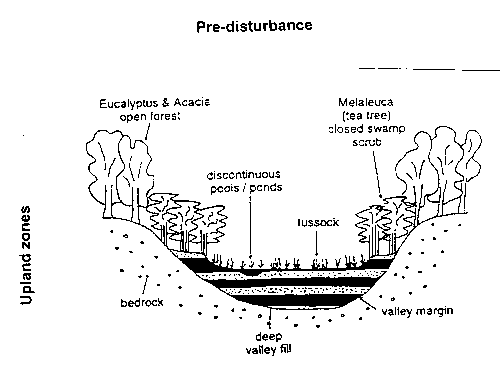
Figure 2.5.1a Planform view of pre-disturbance (left) and post-disturbance (right) channel character within upland, mid-catchment and lowland zones of the Wolumla Creek catchment. After Fryirs et al. (1996). (Note: In the original this was one single figure - it has been split here for presentation purposes. The layout was Row1: a - left, b - right; Row2: c - left, d - right; Row3: e - left, f - right) [enlargement] 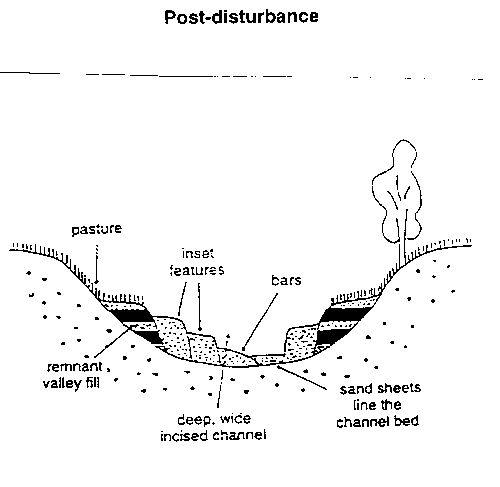
Figure 2.5.1b Planform view of pre-disturbance (left) and post-disturbance (right) channel character within upland, mid-catchment and lowland zones of the Wolumla Creek catchment. After Fryirs et al. (1996). (Note: In the original this was one single figure - it has been split here for presentation purposes. The layout was Row1: a - left, b - right; Row2: c - left, d - right; Row3: e - left, f - right) [enlargement] 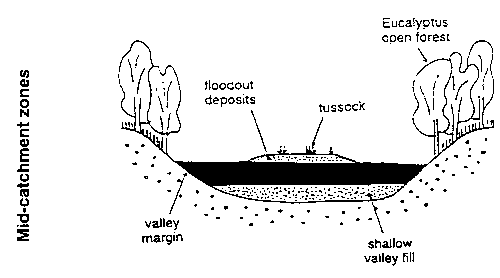
Figure 2.5.1c Planform view of pre-disturbance (left) and post-disturbance (right) channel character within upland, mid-catchment and lowland zones of the Wolumla Creek catchment. After Fryirs et al. (1996). (Note: In the original this was one single figure - it has been split here for presentation purposes. The layout was Row1: a - left, b - right; Row2: c - left, d - right; Row3: e - left, f - right) [enlargement] 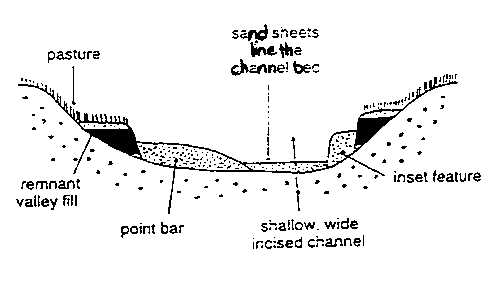
Figure 2.5.1d Planform view of pre-disturbance (left) and post-disturbance (right) channel character within upland, mid-catchment and lowland zones of the Wolumla Creek catchment. After Fryirs et al. (1996). (Note: In the original this was one single figure - it has been split here for presentation purposes. The layout was Row1: a - left, b - right; Row2: c - left, d - right; Row3: e - left, f - right) [enlargement] 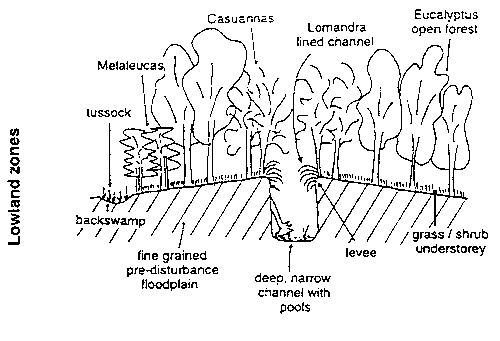
Figure 2.5.1e Planform view of pre-disturbance (left) and post-disturbance (right) channel character within upland, mid-catchment and lowland zones of the Wolumla Creek catchment. After Fryirs et al. (1996). (Note: In the original this was one single figure - it has been split here for presentation purposes. The layout was Row1: a - left, b - right; Row2: c - left, d - right; Row3: e - left, f - right) [enlargement] 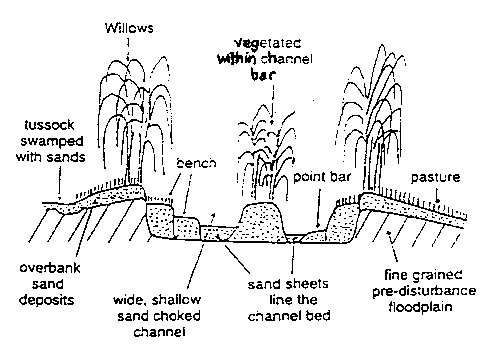
Figure 2.5.1f Planform view of pre-disturbance (left) and post-disturbance (right) channel character within upland, mid-catchment and lowland zones of the Wolumla Creek catchment. After Fryirs et al. (1996). (Note: In the original this was one single figure - it has been split here for presentation purposes. The layout was Row1: a - left, b - right; Row2: c - left, d - right; Row3: e - left, f - right) [enlargement] |
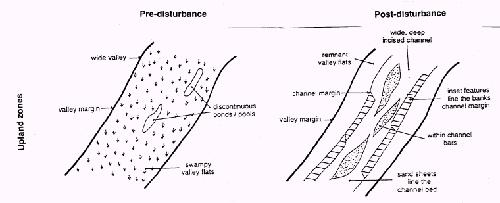
Figure 2.5.2aCross-sectional view of pre-disturbance (left) and post-disturbance (right) channel character within upland, mid-catchment and lowland zones of the Wolumla Creek catchment. After Fryirs et al. (1996). (Note: In the original this was one single figure - it has been split here for presentation purposes. The layout was Row1: a; Row2: b; Row3: c) [enlargement]) 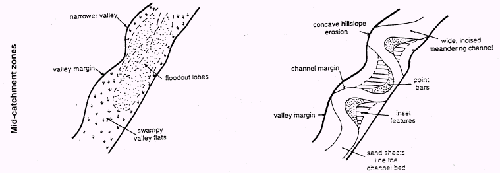
Figure 2.5.2b Cross-sectional view of pre-disturbance (left) and post-disturbance (right) channel character within upland, mid-catchment and lowland zones of the Wolumla Creek catchment. After Fryirs et al. (1996). (Note: In the original this was one single figure - it has been split here for presentation purposes. The layout was Row1: a; Row2: b; Row3: c) [enlargement]) 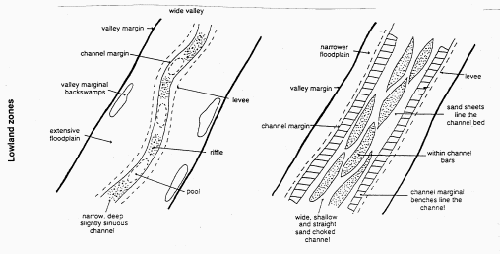
Figure 2.5.2c Cross-sectional view of pre-disturbance (left) and post-disturbance (right) channel character within upland, mid-catchment and lowland zones of the Wolumla Creek catchment. After Fryirs et al. (1996). (Note: In the original this was one single figure - it has been split here for presentation purposes. The layout was Row1: a; Row2: b; Row3: c) [enlargement] |
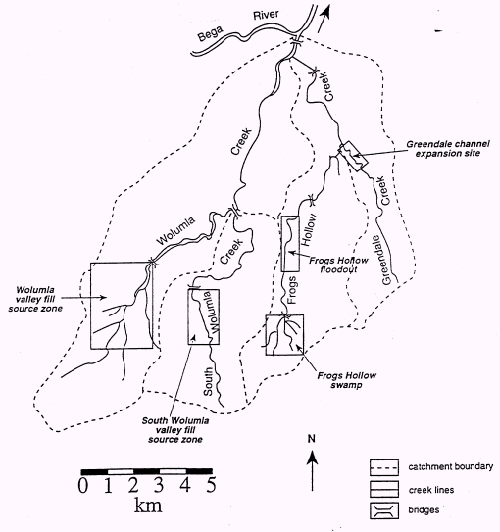
Figure 2.5.3 Identification of sensitive sites in the Wolumla Catchment, based on sediment storage. Frogs Hollow Swamp and Frogs Hollow floodout are intact features which if incised could supply significant volumes of material. Wolumla and South Wolumla valley fill source zones have had the majority of their fills removed, but a significant volume of material still remains stored within these zones. Greendale channel expansion site is an actively eroding transfer zone which is still supplying significant volumes of sediment to Frogs Hollow Creek and is the most sensitive site in the catchment. After Fryirs et al. (1996). |
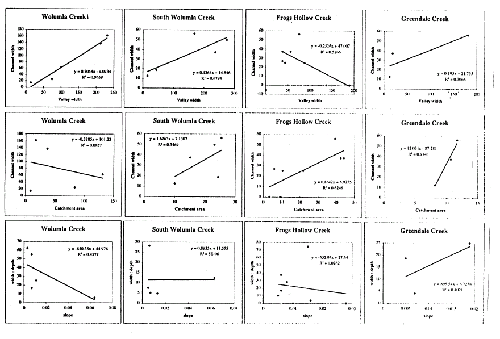
Figure 2.5.4 Predictive relationships between stream characteristics in sub-catchments of the Wolumla Catchment. After Fryirs et al. (1996). [enlargement] |
However, the process of deducing and predicting geomorphic stream characteristics and behaviour is essentially equivalent to deducing and predicting habitat availability because 'geomorphic processes determine the structure, or physical template, of a river system' (Brierley et al., 1999, p840; see also Cohen et al., 1996). In turn, this template provides the 'framework upon which a wide range of biophysical processes interact' (Brierley et al., 1999, p840; see also Resh et al., 1994; Townsend and Hildrew, 1994). Thus, Geomorphic River Styles may have the potential to merge geomorphology and ecology together under the common banner of a physical habitat template.
The implications of geomorphic channel changes for riverine ecology are evaluated by considering lateral and longitudinal connectivity of the river system, the hydrological regime, and the processing and storage of nutrients and organic matter (Brierley et al., 1996). In the Wolumla Catchment, some of the effects of channel behaviour on riverine ecology are reported as:
Despite the potential for Geomorphic River Styles to assess biotic habitat, there has been no direct testing of the relationships between different types of biota and different geomorphic units, or process zones. The view of what constitutes a functional habitat may differ significantly between the geomorphological and the biological perspective. For instance, is the distribution of macroinvertebrate communities within a catchment related to the distribution of source, input, throughput and accumulation zones within a catchment? If certain assemblages of geomorphic units are characteristic of process zones, do macroinvertebrate communities recognise and differentiate between these geomorphic units? Determination of these relationships through future research would provide a strong foundation for linking biotic condition with habitat condition, within a geomorphic process framework.
The State of the Rivers Survey was developed in Queensland, in response to a need for detailed information on the physical and environmental condition of streams and rivers (Anderson, 1993a). This information would then be available to the Queensland Department of Primary Industries (DPI) for use in the Integrated Catchment Management process (Anderson, 1993a). The State of the Rivers Survey is not designed to establish the trend or rate of change of stream condition, but rather, it provides a 'snapshot' of the physical and environmental condition of streams. These data can then be used to:
The State of the Rivers Survey was developed in two stages. The first stage involved development (Anderson, 1993a; Anderson, 1993b) and testing (Anderson, 1993c) of the method. The State of the Rivers Survey has subsequently been applied to assess stream condition in 26 catchments in New South Wales and Queensland (Anderson, 1999).
The State of the Rivers Survey methodology aims to assess the condition of homogenous stream sections within catchments (Anderson, 1993a). The use of homogeneous stream sections facilitates comparison of similar stream types among catchments or sub-catchments, and provides an ability to distinguish inherent natural variability from the effects of human impacts. Division of the catchment into homogeneous stream sections is a hierarchical process that involves the following steps:
Within each stream segment, a representative sampling reach is chosen on the basis of the following criteria:
The number of reaches sampled within each catchment varies according to the size of the catchment and the required resolution of the survey (Anderson, 1993a).
| Table 2.6.1 Data components and types of variables measured in the State of the Rivers Survey. Compiled from the detailed survey data sheets provided in Anderson (1993b). | |
|---|---|
|
Sub-section elements1
Hydrology2
Site description
Reach environs – temporal and spatial
Channel habitat
Cross-sections4
|
Bank condition
Bed and bar condition
Vegetation
Aquatic habitat
Scenic, recreational and conservation values
|
In addition to the map-based data that are used to delineate the initial stream sections, the State of the Rivers Survey consists of 11 data components (Table 2.6.1) that are collected at each representative sampling reach. Each data component is composed of different types of variables that represent the physical and environmental aspects of the stream channel (Table 2.6.1). Variables are generally measured using visual estimation, but some variables require physical measurement or an interpretive rating of condition.
The basis for assessment of stream condition in the State of the Rivers Survey is 'the extent to which the values or perceived function of an attribute has declined from a pristine or undisturbed condition' (Anderson, 1999). A series of condition ratings are produced for each data component. Formulas are used to derive condition ratings, using subsets of variables collected within each component (Anderson 1993b). These condition ratings are based on the extent of degradation from a theoretical maximum of 100%, where 100% percent represents the full value, pristine condition or complete function for the component and 0% represents a complete loss of these (Anderson, 1999). Comparisons with representative sites in good condition are also used to scale the ratings (Anderson, 1999).
Using the condition ratings for each data component, an assessment of condition is derived for each homogeneous stream section (Figure 2.6.1). A final assessment of stream condition within a catchment is achieved by calculating the number of homogeneous stream sections that correspond to each condition rating, for each data component (Figure 2.6.1). The length of stream within each catchment that corresponds to a certain condition can also be calculated (Figure 2.6.1). In addition, an overall condition rating can also be calculated for the whole catchment by resetting the condition ratings for all the data components combined (Anderson, 1993c). Thus, stream condition can be reported on several levels of resolution that can encompass combinations of individual data components or all data components together, as well as individual stream sections or the entire catchment.
The State of the Rivers Survey was designed to 'estimate the ecological condition [of rivers] in terms of the condition of the instream habitat, rather than by conducting flora or faunal surveys' (Anderson, 1993a, p6). As such, the State of the Rivers Survey primarily makes a detailed assessment of components that describe the physical condition of streams, such as channel habitat, bed condition, bank condition, cross-sectional dimension and riparian vegetation (Table 2.6.1). Anderson (1993a) recognised that habitat attributes of general importance to the biota were encompassed by these components. Many of the variables measured in the State of the Rivers Survey correspond with those measured in AUSRIVAS (see Section 2.2), RHS (see Section 2.8) and Habitat Predictive Modelling (see Section 2.7). Therefore, many of the empirical links between biota and habitat that are encompassed within other methods, are potentially represented by the variables collected in the State of the Rivers Survey.
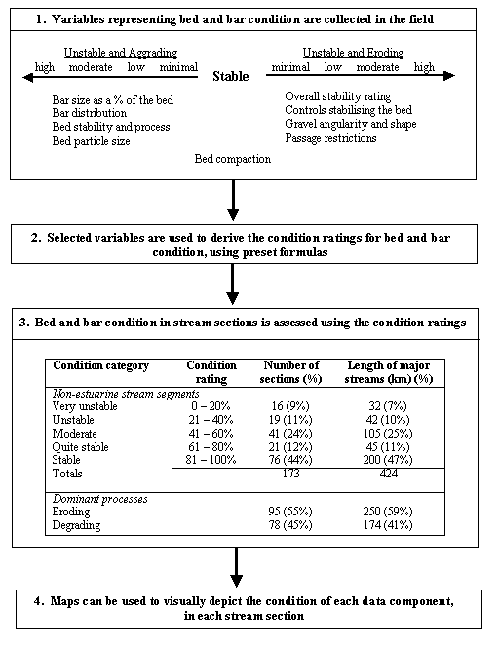
Figure 2.6.1 Steps in assessing stream condition in the State of the Rivers Survey. The example is derived from an assessment of the Maroochy River Catchment, Queensland (Anderson, 1993c), and shows the bed and bank condition data component only. Variables are collected in each stream segment to represent bed and bar conditions. A condition rating is derived using selected variables and preset formulae. The number of sections that correspond to each condition rating are calculated, to give an overall picture of bed and bar condition in the Maroochy Catchment. Diagram compiled from Anderson (1993c). |
Habitat Predictive Modelling is a new, novel method that adds a predictive capacity to assessment of the physical condition of rivers (Davies et al., 2000). As with AUSRIVAS (see Section 2.2), the major advantage of Habitat Predictive Modelling is that the features expected to occur at a site can be predicted, thus forming a target condition against which to measure habitat impairment. This target condition also has the potential to form the desired state for stream rehabilitation efforts (Davies, 1999). Additionally, in the absence of water quality degradation, physical habitat will have a major influence over biotic assemblages (Davies et al., 2000). As such, Habitat Predictive Modelling complements the AUSRIVAS biological assessments of stream condition by providing information on whether biotic impairment at a site is related to poor habitat quality, or to water quality degradation (Davies et al., 2000).
Habitat Predictive Modelling uses a similar approach to AUSRIVAS (see Section 2.2), but uses large-scale catchment features to predict local-scale stream physical habitat features (Davies et al., 2000). Local-scale habitat features are measured at reference sites, which are again defined as sites representing least impaired condition (Figure 2.7.1). Classification analysis is then used to form reference sites into groups containing similar habitat features. Large-scale catchment characteristics, usually measured off maps, are then used to discriminate among the local-scale groups and the variables with the strongest discriminatory power are chosen as predictor variables for use in the predictive model algorithm (Figure 2.7.1).
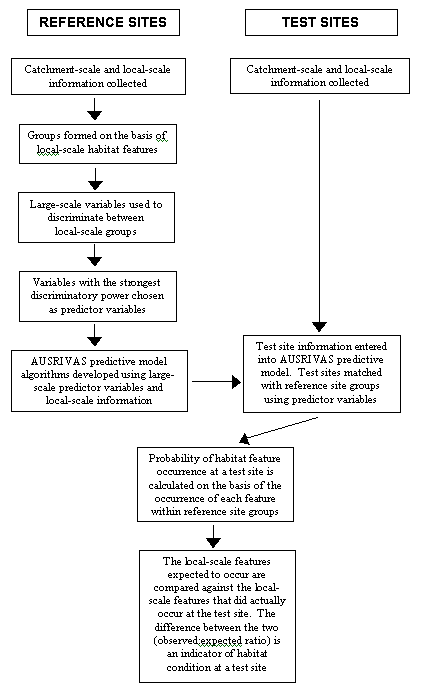
Figure 2.7.1 Schematic representation of Habitat Predictive Modelling and the assessment of habitat condition at a test site. |
As with AUSRIVAS, the reference site information forms the templet against which test sites are compared to assess habitat condition (Figure 2.7.1). Local-scale habitat features are measured at the test sites, along with a suite of larger scale catchment characteristics that includes the predictor variables. These predictor variables are used to place test sites into the reference site groups that were formed on the basis of local-scale habitat features. The model then calculates the probability of occurrence of each habitat feature at a test site, based on the occurrence of that feature within the corresponding reference site groups. The habitat features predicted to occur at a test site are compared against the habitat features that were actually observed at the test site, with the difference between the two being an indication of habitat condition.
Habitat Predictive Modelling is based on the observation that stream systems are organised hierarchically (de Boer, 1992) and that there is a top down control on the expression of habitat features. For example, Frissell et al. (1986) identified five levels of hierarchical organisation: stream systems, segment systems, reach systems, pool/riffle systems and microhabitat subsystems. The characteristics of each level are constrained by physical processes operating at the next highest level. For example, climate and geology act at the larger stream system scale to constrain the expression of bedrock type, longitudinal profile and slope, which are characteristic of the segment scale. In turn, bedrock, longitudinal profile and slope constrain the development of reach systems (Frissell et al., 1986). Although Habitat Predictive Modelling does not aim to capture the same hierarchical levels as Frissell et al. (1986), the prediction of local-scale habitat features from catchment characteristics reflects the constraining relationships between physical processes operating at the large and small levels of the hierarchy. The catchment scale and local-scale variables used in the Habitat Predictive Modelling approach are listed in Table 2.7.1.
Habitat Predictive Modelling assesses stream condition by comparing the local-scale habitat features predicted to occur at a site in the absence of degradation, against the features that were actually observed at a site. The deviation between the two measures (observed:expected ratio) is an indication of habitat quality. This is the same process that is used in AUSRIVAS to detect biological impairment (see Section 2.2). However, in adapting a technique designed to detect biological impairment into a method for assessing habitat condition, several limitations have become apparent. Firstly, AUSRIVAS predicts the occurrence of macroinvertebrate taxon at a site, whereas, there is a need with habitat assessment to predict a more continuous type of data. Currently, the habitat predictive model addresses this by converting each local-scale habitat variable into categories, prior to classification. However, the use of categorical data can result in more than one category being predicted to occur at a site, which may result in a distorted observed:expected ratio (Davies et al., 2000). Secondly, the observed:expected ratio may provide a resolution that is too coarse to accurately reflect habitat condition. For example, one site assessed by Davies et al. (2000) demonstrated an observed:expected ratio of 0.57, which is indicative of impairment. However, examination of the raw data showed that the site actually contained more trees and shrubs than predicted, which indicates that riparian vegetation is not a contributing factor in the habitat impairment observed at this site. Thus, it is suggested that the habitat features predicted to occur should be checked against the observed habitat features to determine if the deviation between them actually represents damage to the stream habitat (Davies et al., 2000). Despite some analytical limitations of Habitat Predictive Modelling, the technique was successful in predicting small-scale habitat features, and represents a promising step forward for habitat assessment.
| Table 2.7.1 List of catchment scale and local scale variables used in Habitat Predictive Modelling. Large-scale variables are the predictor variables and local-scale variables are the habitat features predicted. After Davies (1999). | |
|---|---|
| Large scale habitat variables | Local scale habitat variables |
| Dominant geology in catchment | Riparian width |
| Percent alluvium in catchment | Percent trees greater than 10m in height |
| Percent volcanics in catchment | Percent trees less than 10m in height |
| Percent metasediments in catchment | Percent shrubs and vines |
| Percent limestone in catchment | Percent grasses, ferns and sedges |
| Dominant soil type in catchment | Shading of reach |
| Annual mean rainfall | Stream width |
| Annual median rainfall | Bank width |
| Catchment area | Bank height |
| Maximum catchment length | Percent riffle habitat |
| Mean catchment slope | Riffle depth |
| Difference in elevation between source and mouth | Riffle velocity |
| Relief ratio | Percent edge habitat |
| Drainage density | Edge depth |
| Form ratio | Percent boulder in the reach |
| Elongation ratio | Percent cobble in the reach |
| Total stream length | Percent pebble in the reach |
| Valley floor width | Percent gravel in the reach |
| Valley slope | Percent sand in the reach |
| Stream order | Percent silt in the reach |
| Altitude | Percent clay in the reach |
| Distance from source | Percent bedrock in the riffle |
| Latitude | Percent boulder in the riffle |
| Longitude | Percent cobble in the riffle |
| Alkalinity | Percent pebble in the riffle |
| Conductivity | Percent gravel in the riffle |
| pH | Percent sand in the riffle |
| Edge bank vegetation | |
| Percent bedrock in the edge | |
| Percent boulder in the edge | |
| Percent cobble in the edge | |
| Percent pebble in the edge | |
| Percent gravel in the edge | |
| Percent sand in the edge | |
| Percent silt in the edge | |
| Bottom substrate availability habitat assessment score | |
| Velocity / depth category habitat assessment score | |
| Channel alteration habitat assessment score | |
| Scouring habitat assessment score | |
| Pool / riffle / run / bend habitat assessment score | |
| Bank stability habitat assessment score | |
| Vegetative stability habitat assessment score | |
| Vegetation cover habitat assessment score | |
| Total habitat assessment score | |
Habitat Predictive Modelling is a habitat based approach and thus, it does not attempt to integrate biological aspects. However, the method has the potential to link physical features with biota, particularly macroinvertebrates, in two ways:
The River Habitat Survey (RHS) is a river assessment method used in the United Kingdom. The RHS arose from a need to develop a nationally standardised system to measure, classify and report on the physical structure of rivers (Raven et al., 1997). In designing the RHS, consideration was given to seven basic requirements. Thus, the RHS should:
Information derived from the RHS is designed to assist river management decisions and provide an ability to predict the physical features of a stream that would occur under unmodified conditions (Raven et al., 1997). The RHS was conducted in two phases. The first phase involved the design and testing of survey methods as well as sampling of a reference site data base of more than 3000 stream sites across the U.K. (Fox et al., 1998). The second phase is currently under-way and aims to use the RHS in management applications such as catchment management plans, environmental impact assessments, stream rehabilitation plans and wildlife conservation (Raven et al., 1998b).
The RHS uses the physical structure of streams to assess the character and quality of rivers (Table 2.8.1). Statistical theory was used to aid the survey design and the selection of sampling sites throughout the U.K. (Jeffers, 1998b, Fox et al., 1998). At each randomly selected site, a 500m length of river is surveyed. At 50m intervals along this length of river, 10 spot checks are performed. A range of features is recorded at each spot check (Table 2.8.1). To ensure that features and modifications not occurring at the spot checks are included, a sweep up checklist is also completed (Raven et al., 1998b). In addition, cross sectional measurements of water and bankfull width, bank height and water depth (Table 2.8.1) are made at one representative location within the 500m sampling site (Raven et al., 1998b). When used in conjunction with the survey data, these measurements provide information about the geomorphological processes acting on the site (Raven et al., 1997). Map variables such as altitude, slope, planform and geology (Table 2.8.1) are measured in the laboratory. Data are entered onto an electronic database and photos of each sampling site are also stored electronically (Raven et al., 1998b).
| Table 2.8.1 Variables measured in the River Habitat Survey. (sc) denotes variables collected at spot checks. After Fox et al. (1998). | |
|---|---|
Background and map derived data
Channel data
|
Bank data (left and right recorded separately)
Other site data
|
The RHS takes the view that 'in rivers, habitat is the result of predictable physical processes and so conveniently sits between the forces which structure rivers and the biota which inhabit them' (Harper and Everard, 1998 p395). Thus, the RHS measures variables that represent the character of stream habitats, with the assumption that these variables reflect the geomorphological processes that are acting to form those habitats (Newson et al., 1998b). While geomorphological theory underlies many of the variables collected, the RHS is not strictly a geomorphological survey and specific measurements of geomorphic processes rates are not considered (Newson et al., 1998b).
In RHS, the basis for assessing habitat quality, using the information collected at individual 500m sampling sites is:
Habitat quality assessment can be achieved using four main approaches (Figure 2.8.1). In the first approach, habitat quality is assessed by identifying sites that have pristine and modification free channel characteristics and which are located in areas with a semi-natural land use. In the second and third approaches, reference site groups that represent similar river types are derived, and rarity of individual features or combinations of features is determined within these reference site groups. In the fourth approach, a habitat quality assessment (HQA) score is calculated from the presence and extent of habitat features recorded in the survey (Raven et al., 1998a). The extent of artificial modification in the channel can also be expressed as a separate habitat modification score (HMS, Raven et al., 1998b).
| Figure 2.8.1 Four approaches to assessment of habitat quality in the River Habitat Survey. After Raven et al. (1998b). | |
|---|---|
| QUESTION | BASIS FOR ANSWER |
| 1] Is the site outstanding? | Must have pristine (totally unmodified) channel AND exclusively semi-natural land-use |
| 2] Is the site of high habitat quality based on the occurrence of one or more rare features? | Presence of at least one natural feature which occurs in 5% or less of RHS reference sites within a particular geographical region and/or of the same river type |
| 3] Is the site of high habitat quality based on the occurrence of a rare combination of features? | Presence of a combination of natural features which occurs in 5% or less of RHS reference sites within a particular geographical region and/or of the same river type |
| 4] How does the HQA score for the site compare with other sites of the same river type? | Compare it with all HQA scores from RHS reference sites of the same river type, if possible calibrated using a top quality benchmark site |
Although still under investigation, one promising outcome of the RHS is an ability to predict the features that are likely to occur in a stretch of river, from map based variables (Jeffers, 1998a). This predictive ability will potentially assist in identifying the effects of channel modification, as well as enabling targets against which rehabilitation efforts can be measured.
The focus of the RHS on the measurement of habitat quality reflects the underlying assumption that biotic diversity is directly related to habitat diversity (Harper and Everard, 1998). To bridge these two concepts, the RHS uses both a biotope and a functional habitat approach (Newson et al., 1998a). The biotope approach is top down in that the use of habitat units by biota is inferred from a knowledge physical conditions (Newson et al., 1998a). The functional habitat approach is bottom up, in that each habitat is defined from knowledge of the biota that are found in each habitat (Newson et al., 1998a). Thus, it is assumed that by assessing habitat features within this framework the physical influences on biotic composition and the physical influences on habitat formation will both be included.
As mentioned in the previous section, assessment of habitat quality considers the occurrence of habitat features that are of known value to wildlife. The link between these features and wildlife is treated slightly differently in each of the four main approaches. In the first approach, the focus on naturalness reflects the value of this state to wildlife conservation (Raven et al., 1998a). In the second and third approaches, rarity can include features that are of known value to wildlife (Raven et al., 1998a). In the fourth approach, the HQA score considers the presence or absence of features that are of known wildlife interest (Raven et al., 1998a). While there is an empirical basis for the relationships between physical features and biotic structure and process (Resh and Rosenberg, 1984; Harper and Everard, 1998), there is an implicit assumption that the features included in assessments of habitat quality, and in the RHS in general, reflect those relationships. This has not been specifically tested, however, one promising development that may strengthen knowledge in this area is the proposal to link the RHS with the biological assessment program RIVPACS (Wright et al., 1998).
The following provides a summary of the advantages and disadvantages of each of the seven river assessment methods examined in detail in the previous section. Each method was developed for a different purpose and thus, the use of the term 'advantages' and 'disadvantages' are not judgements about the relative value of each method as an individual tool for river assessment. Rather, examination of advantages and disadvantages is framed in light of the potential for each method, or components of each method, to fit the requirements of a standardised physical and chemical assessment protocol, within an AUSRIVAS style framework.
Advantages
Potential disadvantages
Sampling and data collection issues
Advantages
Potential disadvantages
Sampling and data collection issues
Advantages
Potential disadvantages
Sampling and data collection issues
Advantages
Potential disadvantages
Sampling and data collection issues
Advantages
Potential disadvantages
Sampling and data collection issues
Advantages
Potential disadvantages
Sampling and data collection issues
Advantages
Disadvantages
Sampling and data collection issues
Each of the river assessment methods considered in this review was developed for a specific purpose and thus, the methods reflect a range of management goals and scientific approaches. However, development of a standardised protocol for the physical and chemical assessment of river condition requires consideration of the following specific qualities:
The representation of each of these qualities within the seven river assessment methods examined in this review is summarised in Table 3.2.1. Overall, the methods generally use rapid data collection and analysis methods, they have the potential for use by non-experts and their scientific outputs are presented in a form that is easily interpreted by managers (Table 3.2.1). Each of the methods also has some capacity to assess stream condition against a reference state, however, the degree to which this function is utilised in determining site condition varies among the methods. Similarly, the methods vary widely in predictive ability, applicability to a wide range of river types across Australia and scale of focus (Table 3.2.1). Differences between the dominant paradigms of stream ecology and geomorphology are reflected by two criteria: the incorporation of parameters relevant to biota and the representation of important geomorphological processes (Table 3.2.1). Geomorphic River Styles, State of the Rivers Survey and River Habitat Survey were each designed to assess physical or geomorphological aspects of streams and thus, they attempt to incorporate empirical relationships between physical parameters and biota indirectly. Conversely, AUSRIVAS, HABSCORE and Index of Stream Condition have a strong biological component and thus, they fail to fully consider geomorphological processes. Finding common ground between biologically and geomorphologically relevant parameters would provide a more holistic perspective on the assessment of stream condition.
| Table 3.2.1 Evaluation of seven river assessment methods against the desired qualities of a standardised physical and chemical assessment protocol. The representation of each of the qualities by the methods is designated as yes (Y), no (N), potentially (P) or indirectly (I). | |||||||
|---|---|---|---|---|---|---|---|
| Desired qualities of the physical and chemical assessment protocol | Potential methods for inclusion in the physical and chemical assessment protocol | ||||||
| AUSRIVAS | HABSCORE | Index of Stream Condition | Geomorphic River Styles | State of the Rivers Survey | Habitat Predictive Modelling | River Habitat Survey | |
| Scale of focus commensurate with the AUSRIVAS biological monitoring protocol | Y | Y | N | P | P | Y | P |
| Capacity to measure stream condition against a desirable reference state | Y | Y | Y | I | Y | Y | I |
| Incorporation of parameters that are relevant to the biota, particularly macroinvertebrates | Y | Y | Y | P | P | Y | P |
| Representation of important geomorphological processes that influence the formation of stream habitat | N | N | N | Y | I | P | Y |
| Conformity with a rapid philosophy of data collection and analysis | Y | Y | N | N | Y | Y | Y |
| Potential for use by non-experts | Y | Y | Y | N | Y | Y | Y |
| Scientific outputs presented in a form that is easily interpreted by managers | Y | Y | Y | P | Y | Y | Y |
| Adaptability and applicability to a wide range of river types across Australia | Y | P | P | P | P | Y | P |
| Ability to predict physical stream characteristics | Y | N | N | Y | N | Y | P |
As discussed in Section 1.1, development of a protocol for the physical assessment of stream condition that is complementary to AUSRIVAS requires simultaneous consideration of biological and geomorphological methods and approaches. This review is a first step towards merging the two approaches to stream assessment, and provides an information base that that will be built upon at the habitat assessment workshop, scheduled for 2-3 May, 2000. The habitat assessment workshop will bring together geomorphologists, hydrologists and ecologists and will involve the authors of several of the methods covered in this review. The aim of the workshop is to develop a framework for a standardised physical and chemical assessment protocol. One of the main challenges of the workshop will be to determine the physical variables that are relevant to biota, and to determine the most suitable methods for measuring these variables in a cost effective manner, and within a rapid sampling philosophy. Specifically, it is hoped that the questions posed in Section 1.1 will be answered in detail during the course of the workshop to form the basis for a standardised physical and chemical assessment protocol. The outcomes and recommendations from the habitat assessment workshop will be reported in a future document.
 Riversinfo Australia (au.riversinfo.org): Publication Information:
Riversinfo Australia (au.riversinfo.org): Publication Information:
Current at December 2002
 au.riversinfo.org has been developed to facilitate public access to scientific and technical information on Australia's Rivers. Much of this material was paid for using public funds and is therefore owned by the Australian people. Environment Australia have been instrumental in making available all the publications from:
au.riversinfo.org has been developed to facilitate public access to scientific and technical information on Australia's Rivers. Much of this material was paid for using public funds and is therefore owned by the Australian people. Environment Australia have been instrumental in making available all the publications from:
 The au.riversinfo.org Internet site is in-part supported by the Natural Heritage Trust. The Natural Heritage Trust focuses on five key environmental themes - land, vegetation, rivers, coasts and marine, and biodiversity. The programs of the Natural Heritage Trust play a major role in developing sustainable agriculture and natural resource management, as well as protecting our unique biodiversity through improved management and delivery of resources.
The au.riversinfo.org Internet site is in-part supported by the Natural Heritage Trust. The Natural Heritage Trust focuses on five key environmental themes - land, vegetation, rivers, coasts and marine, and biodiversity. The programs of the Natural Heritage Trust play a major role in developing sustainable agriculture and natural resource management, as well as protecting our unique biodiversity through improved management and delivery of resources.
 The au.riversinfo.org Internet site is in-part supported by Sydney Airport who have co-funded a Natural Heritage Trust supported project intended to develop Internet based environmental information integration and management systems. This will assist in developing an overall perspective on the demands and uses for environmental resources
The au.riversinfo.org Internet site is in-part supported by Sydney Airport who have co-funded a Natural Heritage Trust supported project intended to develop Internet based environmental information integration and management systems. This will assist in developing an overall perspective on the demands and uses for environmental resources